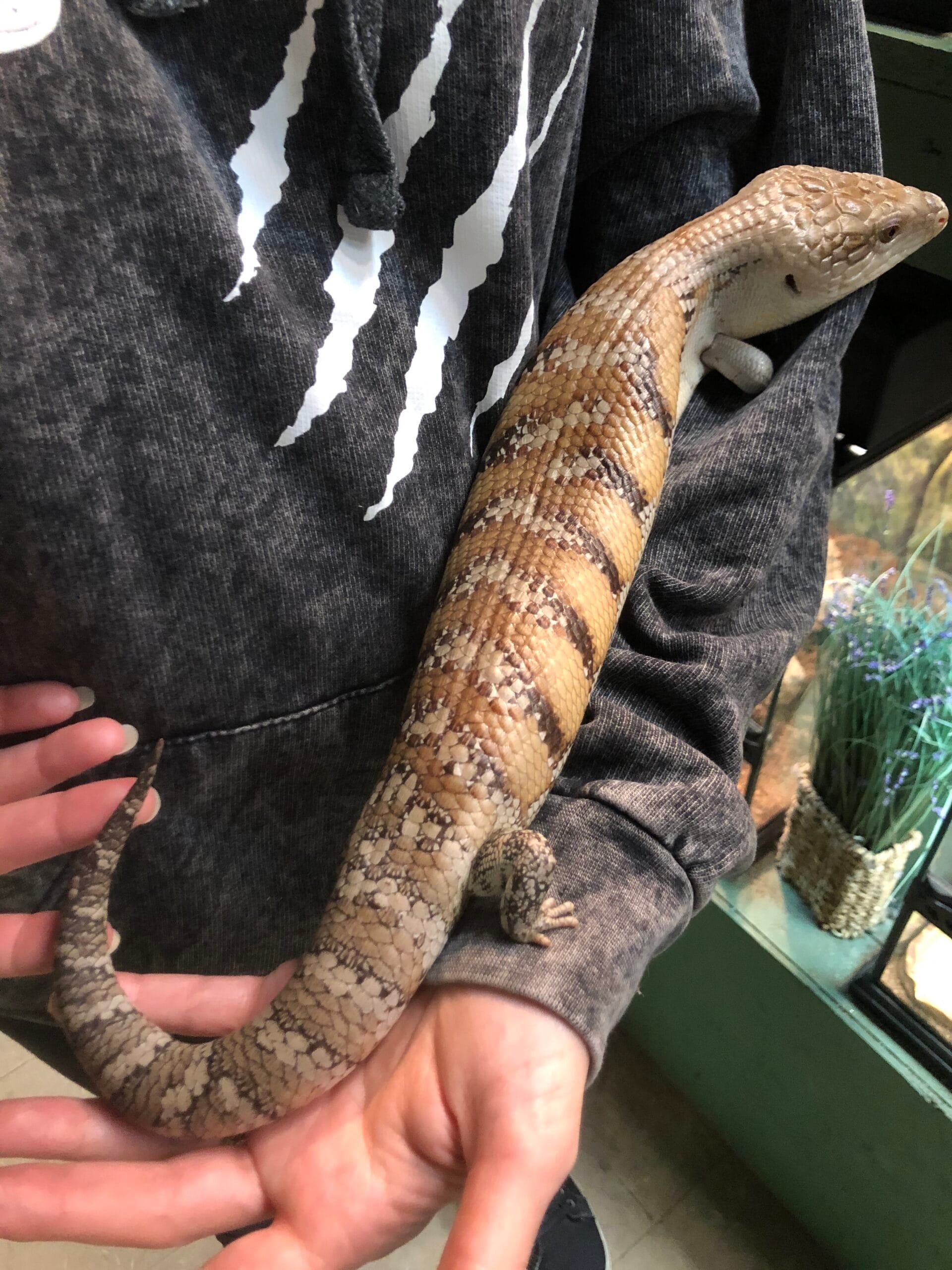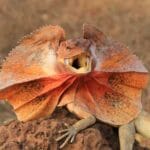Meet the Northern Blue Tongue Skink, a lizard with a striking blue tongue! These gentle creatures are popular among reptile lovers. In this guide, we’ll delve into the captivating world of the Northern Blue Tongue Skink, exploring their habits, habitat, and unique quirks. Whether you’re a seasoned owner or simply curious about these fascinating animals, join us as we uncover the secrets of these intriguing creatures.
Unveiling the Northern Blue Tongue Skink
The northern blue tongue skink—it’s a mouthful, isn’t it? But don’t let the name fool you; this reptile is as fascinating as it is friendly. We’re talking about the biggest of all the blue tongue skinks, native to Australia’s northern landscapes. And trust us, once you get to know them, you’ll understand why they’re a favorite down under.
A Look That’s Uniquely Their Own
How can you identify a Northern Blue Tongue Skink? Imagine a lizard adorned with scales that shimmer in shades from fiery orange to a soft, peachy hue. Bold, dark stripes run down their back and sides, contrasting with a creamy underside—a pretty stylish ensemble, wouldn’t you say? And of course, we can’t forget the most obvious feature—that iconic bright blue tongue that gives them their name. This remarkable feature isn’t just for show—it serves a crucial purpose in their survival.
With their sturdy build and short legs, Northern Blue Tongue Skinks possess a distinctive look. Reaching up to 22 inches in length, these gentle giants are the largest of all the blue tongue skink species.
Living the Good Life Down Under
As sun-loving Australians, Northern Blue Tongue Skinks can be found basking in the warmth across the diverse landscapes of Northern Australia. From woodlands to grasslands, they are adaptable creatures who are most active during the day. And when we say active, we mean exploring every nook and cranny in search of a tasty treat.
These skinks are far from picky eaters. Their omnivorous diet includes a diverse menu of insects, snails, juicy fruits, and berries, providing them with the energy they need for their explorations.
Gentle Giants with a Protective Streak
While these reptiles have a reputation for being laid-back, even the most easygoing creatures require a defense mechanism. The Northern Blue Tongue Skink has a few tricks up its sleeve to ward off potential threats.
If they sense danger, they aren’t afraid to put on a show of force. They gape their mouths wide open, letting out a loud hiss, and of course, flashing that famous blue tongue. This impressive display is often enough to startle and deter any would-be predators.
Family Matters: Raising the Next Generation
As the weather warms up in late spring, the Northern Blue Tongue Skink turns its attention to family matters. Males, eager to impress females, engage in a rather unique courtship ritual—they bite the females’ backs! It might sound a bit rough, but it’s all part of their natural behavior.
What’s truly remarkable about these skinks is that instead of laying eggs, the mothers carry their young for about 100 days before giving birth to live babies. These dedicated mothers can have litters of up to 20 offspring! From day one, the baby skinks are ready to explore their surroundings and will even consume small insects and fruits.
Facing the Future: Challenges and Conservation
Northern Blue Tongue Skinks are a common sight in Australia, but that doesn’t mean they are immune to challenges. Like many native species, they are facing habitat loss due to human activities such as land clearing and development. Introduced predators, such as cane toads, also pose a significant threat to their populations. Understanding the importance of their role in the ecosystem and protecting their homes is crucial to ensuring these gentle giants continue to thrive.
A Glimpse into the World of the Northern Blue Tongue Skink
From their distinctive appearance to their intriguing behaviors, these reptiles are a testament to the wonders of the natural world. The Northern Blue Tongue Skink reminds us that even in a world that’s constantly changing, there’s still so much beauty and wonder to discover right in our own backyards.
Are Northern Blue Tongue Skinks Friendly?
Known for their gentle nature, Northern Blue Tongue Skinks have earned a reputation as “gentle giants.” These captivating creatures are generally mellow and tolerant of handling, especially when they’ve been accustomed to it from a young age.
While they might not demand cuddles like a puppy, they are unlikely to bite simply because you need to move them or clean their enclosure. Their forgiving nature makes them relatively easy to handle for routine care, such as vet visits.
It’s important to remember, however, that these fascinating reptiles are solitary creatures by nature. While they may tolerate interaction with their human caregivers, they prefer their own company to cohabitating with other skinks. Forcing them to live together, especially males, can lead to territorial disputes and unnecessary stress. Providing them with a spacious enclosure all to themselves, furnished with enriching elements, is key to keeping them happy and stress-free.
What is the difference between Indonesian and Northern Blue Tongue Skinks?
While both Indonesian and Northern Blue Tongue Skinks share the spotlight for their striking blue tongues, they have distinct differences in terms of their origins, care requirements, and conservation status.
One of the biggest differences is where they are sourced. Northern Blue Tongue Skinks are often bred in captivity, making them readily available at pet stores or from reputable breeders. Indonesian Blue Tongue Skinks, on the other hand, are more likely to be wild-caught due to export restrictions from their native countries. It’s crucial to consider the ethical implications of buying wild-caught animals and the potential impact on their well-being and wild populations.
Climate Control: A Tale of Two Climates
Northern Blue Tongue Skinks are a hardy bunch. Hailing from regions that can get chilly, they are accustomed to fluctuating temperatures and require a thermal gradient in their enclosure. This means providing them with both a warm basking spot and a cooler retreat, allowing them to regulate their body temperature as needed.
Indonesian Blue Tongue Skinks, in contrast, prefer a consistently warm and tropical environment, much like their native island homes. They are not as tolerant of cooler temperatures and require higher humidity levels, which can be maintained through methods such as misting and providing a humid hide within their enclosure.
Understanding Their Needs
While their blue tongues may appear similar, the care requirements of Indonesian and Northern Blue Tongue Skinks differ significantly. These variations stem from their unique adaptations to their respective habitats. It is essential to research and understand the specific needs of each type to ensure their well-being in captivity.
Are Northern Blue Tongue Skinks Rare?
Thanks to successful breeding programs, Northern Blue Tongue Skinks are not considered rare in the pet trade. However, their availability as pets shouldn’t overshadow the challenges their wild counterparts face in their native Australia, where habitat loss due to deforestation, development, and other human-induced changes pose a significant threat.
It is crucial to remember that the well-being of these creatures extends beyond our homes. By supporting conservation efforts, choosing captive-bred animals, and educating ourselves about responsible pet ownership, we can contribute to their long-term survival and help ensure that future generations can continue to marvel at these gentle giants of the outback.
If you are looking for a venomous snake, check out the northern copperhead snake. It is a species of venomous snake found in eastern North America and is the only venomous species of the family Colubridae. For a non-venomous option, the peacock tarantula is a gentle and colorful creature that can make a great pet for the right person.
- Georgia Platform: A Southern Strategy, 1850s - March 31, 2025
- How many weeks is 40 days: Quick Conversion Guide for Accurate Results - March 31, 2025
- How many feet is 300 meters? 984 Feet: Understand Length Conversions Easily - March 31, 2025
















